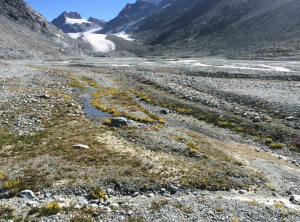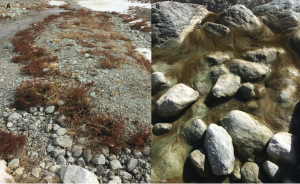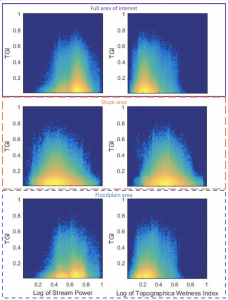Hannah Miller (Fulbright scholarship holder)
Supervisor: Professor Stuart Lane
My primary interest is on biogeomorphic feedbacks between microbes, vegetation and the physical environment during ecosystem succession of recently deglaciated terrain. More rapid glacial retreat may be altering the abiotic processes within glacial forefields, with recent research highlighting how water dynamics and perturbation potential create dynamic gradients of physical stress that exert a strong control on ecosystem succession.

Figure 1: Vegetation zonation along channels within the forefield of Glacier d’Otemma most likely driven by gradients in water availability and perturbation potential
Additionally, new understanding of the ecosystem engineering role of microbes and vegetation within glacial forefields makes it important to consider the role of biogeomorphic feedbacks as a mechanistic driver of succession.

Figure 2: A) Vegetation growing alongside and B) and within glacially-fed meltwater channels in the forefield of Otemma. These organisms have the potential to engineer the local environment influencing water and perturbation dynamics.
These concepts are being explored in the forefield of Glacier d’Otemma (Valais, Switzerland) using remote sensing techniques, and field based methods. My remote sensing techniques involve using high resolution DEM data to construct a wetness index and stream power within the forefield, as a means of understanding the balance between perturbing processes (a function of stream power) and resources (a function of water availability). The field component of this work will assess vegetation composition, in addition to gradients in moisture availability and disturbance processes.

Figure 3: Probability distribution functions of vegetation distribution (TGI, the triangular green index), stream power, and wetness index for three areas within the forefield of the Glacier d’Otemma. Vegetation can be seen to be constrained within intermediate values of perturbation and wetness suggesting these factors create stress gradients that exert a strong control on vegetation development
